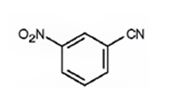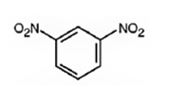
a) Bromobenzene
Interpretation:
The major product(s) formed when bromobenzene is nitrated is to be given. Whether it will react faster or slower than benzene is also to be stated.
Concept introduction:
Monosubstituted benzenes can be nitrated using a mixture of Conc. HNO3 and H2SO4. Electron releasing substituent groups, excep halogens, activate the ring and direct the incoming electrophile to the o- and p-positions. Compounds with these substituent groups are more reactive than benzene. Halogens are o- and p-directors but they deactivate the ring. Hence halobenzenes are less reactive than benzene. Electron withdrawing substituent groups deactivate the ring and direct the incoming electrophile to the m-position. Compounds with these substituent groups are less reactive than benzene.
To give:
The major products formed when bromobenzene is nitrated and to state whether it will react faster or slower than benzene.
Answer to Problem 47AP
The major products formed when bromobenzene is nitrated are o-bromonitrobenzene and p-bromonitrobenzene.

Bromobenzene will react slower than benzene.
Explanation of Solution
Bromine is an o- and p-directing group. It also has considerable electron withdrawing inductive effect which deactivates the ring. Hence bromobenzene is less reactive than benzene.

The major products formed when bromobenzene is nitrated are o-bromonitrobenzene and p-bromonitrobenzene.

Bromobenzene will react slower than benzene.
b) Benzonitrile
Interpretation:
The major product(s) formed when benzonitrile is nitrated is to be given. Whether it will react faster or slower than benzene is also to be stated.
Concept introduction:
Monosubstituted benzenes can be nitrated using a mixture of Conc. HNO3 and H2SO4. Electron releasing substituent groups, except halogens, activate the ring and direct the incoming electrophile to the o- and p-positions. Compounds with these substituents are more reactive than benzene. Halogens are o- and p-directors but they deactivate the ring. Hence halobenzenes are less reactive than benzene. Electron withdrawing substituent groups deactivate the ring and direct the incoming electrophile to the m-position. Compounds with these substituents are less reactive than benzene.
To give:
The major products formed when benzonitrile is nitrated and to state whether it will react faster or slower than benzene.
Answer to Problem 47AP
The major product formed when benzonitrile is nitrated is m-nitrobenzonitrile.

Benzonitrile will react slower than benzene.
Explanation of Solution
The cyanide group is strongly electron withdrawing in nature. Hence it is a meta director. The attraction of electrons away from the ring reduces the electron density in the ring. Thus benzonitrile reacts slower than benzene.

The major product formed when benzonitrile is nitrated is m-nitrobenzonitrile.

Benzonitrile will react slower than benzene.
c) Benzoic acid
Interpretation:
The major product(s) formed when benzoic acid is nitrated is to be given. Whether it will react faster or slower than benzene is also to be stated.
Concept introduction:
Monosubstituted benzenes can be nitrated using a mixture of Conc. HNO3 and H2SO4. Electron releasing substituent groups, except halogens, activate the ring and direct the incoming electrophile to the o- and p-positions. Compounds with these substituents are more reactive than benzene. Halogens are o- and p-directors but they deactivate the ring. Hence halobenzenes are less reactive than benzene. Electron withdrawing substituent groups deactivate the ring and direct the incoming electrophile to the m-position. Compounds with these substituents are less reactive than benzene.
To give:
The major products formed when benzoic acid is nitrated and to state whether it will react faster or slower than benzene.
Answer to Problem 47AP
The major product formed when benzoic acid is nitrated is m-nitrobenzoic acid.

Benzoic acid will react slower than benzene.
Explanation of Solution
The C=O in carboxyl group is strongly electron withdrawing in nature. Hence it is a meta director. The attraction of electrons away from the ring reduces the electron density in the ring. Thus benzoic acid reacts slower than benzene.

The major product formed when benzoic acid is nitrated is m-nitrobenzoic acid.

Benzoic acid will react slower than benzene.
d) Nitrobenzene
Interpretation:
The major product(s) formed when nitrobenzene is nitrated is to be given. Whether it will react faster or slower than benzene is also to be stated.
Concept introduction:
Monosubstituted benzenes can be nitrated using a mixture of Conc. HNO3 and H2SO4. Electron releasing substituent groups, except halogens, activate the ring and direct the incoming electrophile to the o- and p-positions. Compounds with these substituents are more reactive than benzene. Halogens are o- and p-directors but they deactivate the ring. Hence halobenzenes are less reactive than benzene. Electron withdrawing substituent groups deactivate the ring and direct the incoming electrophile to the m-position. Compounds with these substituents are less reactive than benzene.
To give:
The major products formed when nitrobenzene is nitrated and to state whether it will react faster or slower than benzene.
Answer to Problem 47AP
The major product formed when nitrobenzene is nitrated is m-dinitrobenzene.

Nitrobenzene will react slower than benzene.
Explanation of Solution
The nitro group is strongly electron withdrawing in nature. Hence it is a meta director. The attraction of electrons away from the ring reduces the electron density in the ring. Thus nitrobenzene reacts slower than benzene.

The major product formed when nitrobenzene is nitrated is m-dinitrobenzene.

Nitrobenzene will react slower than benzene.
e) Benzenesulfonic acid
Interpretation:
The major product(s) formed when benzenesulfonic acid is nitrated is to be given. Whether it will react faster or slower than benzene is also to be stated.
Concept introduction:
Monosubstituted benzenes can be nitrated using a mixture of Conc. HNO3 and H2SO4. Electron releasing substituent groups, except halogens, activate the ring and direct the incoming electrophile to the o- and p-positions. Compounds with these substituents are more reactive than benzene. Halogens are o- and p-directors but they deactivate the ring. Hence halobenzenes are less reactive than benzene. Electron withdrawing substituent groups deactivate the ring and direct the incoming electrophile to the m-position. Compounds with these substituents are less reactive than benzene.
To give:
The major products formed when benzenesulfonic acid is nitrated and to state whether it will react faster or slower than benzene.
Answer to Problem 47AP
The major product formed when benzenesulfonic acid is nitrated is m-nitro benzenesulfonic acid.

Benzenesulfonic acid will react slower than benzene.
Explanation of Solution
The sulfonic acid group is strongly electron withdrawing in nature. Hence it is a meta director. The attraction of electrons away from the ring reduces the electron density in the ring. Thus benzenesulfonic acid reacts slower than benzene.

The major product formed when benzenesulfonic acid is nitrated is m-nitro benzenesulfonic acid.

Benzenesulfonic acid will react slower than benzene.
f) Methoxybenzene
Interpretation:
The major product(s) formed when methoxybenzene is nitrated is to be given. Whether it will react faster or slower than benzene is also to be stated.
Concept introduction:
Monosubstituted benzenes can be nitrated using a mixture of Conc. HNO3 and H2SO4. Electron releasing substituent groups, except halogens, activate the ring and direct the incoming electrophile to the o- and p-positions. Compounds with these substituents are more reactive than benzene. Halogens are o- and p-directors but they deactivate the ring. Hence halobenzenes are less reactive than benzene. Electron withdrawing substituent groups deactivate the ring and direct the incoming electrophile to the m-position. Compounds with these substituents are less reactive than benzene.
To give:
The major products formed when methoxybenzene is nitrated and to state whether it will react faster or slower than benzene.
Answer to Problem 47AP
The major products formed when methoxybenzene is nitrated are o-nitromethoxybenene and p-nitromethoxybenene.

Methoxybenzene will react faster than benzene.
Explanation of Solution
The methoxy group is electron releasing in nature. Hence it is an o- and p-director. The attraction of electrons towards the ring increases the electron density in the ring. Thus methoxybenzene reacts faster than benzene.

The major products formed when methoxybenzene is nitrated are o-nitromethoxybenene and p-nitromethoxybenene.

Methoxybenzene will react faster than benzene.
Want to see more full solutions like this?
Chapter 16 Solutions
Organic Chemistry - With Access (Custom)
- Curved arrows are used to illustrate the flow of electrons. Using the provided starting and product structures, draw the curved electrons-pushing arrows for the following reaction or mechanistic step(s).arrow_forwardCurved arrows are used to illustrate the flow of electrons. Using the provided starting and product structures, draw the curved electron-pushing arrows for the following reaction or mechanistic step(s). Be sure to account for all bond-breaking and bond-making steps. I I I H Select to Add Arrows HCI, CH3CH2OHarrow_forwardCurved arrows are used to illustrate the flow of electrons. Use the reaction conditions provided and the follow the arrows to draw the intermediate and product in this reaction or mechanistic step(s).arrow_forward
- Curved arrows are used to illustrate the flow of electrons. Use the reaction conditions provided and follow the curved arrows to draw the intermediates and product of the following reaction or mechanistic step(s).arrow_forwardCurved arrows are used to illustrate the flow of electrons. Use the reaction conditions provided and follow the arrows to draw the intermediate and the product in this reaction or mechanistic step(s).arrow_forwardLook at the following pairs of structures carefully to identify them as representing a) completely different compounds, b) compounds that are structural isomers of each other, c) compounds that are geometric isomers of each other, d) conformers of the same compound (part of structure rotated around a single bond) or e) the same structure.arrow_forward
- Given 10.0 g of NaOH, what volume of a 0.100 M solution of H2SO4 would be required to exactly react all the NaOH?arrow_forward3.50 g of Li are combined with 3.50 g of N2. What is the maximum mass of Li3N that can be produced? 6 Li + N2 ---> 2 Li3Narrow_forward3.50 g of Li are combined with 3.50 g of N2. What is the maximum mass of Li3N that can be produced? 6 Li + N2 ---> 2 Li3Narrow_forward
- Concentration Trial1 Concentration of iodide solution (mA) 255.8 Concentration of thiosulfate solution (mM) 47.0 Concentration of hydrogen peroxide solution (mM) 110.1 Temperature of iodide solution ('C) 25.0 Volume of iodide solution (1) used (mL) 10.0 Volume of thiosulfate solution (5:03) used (mL) Volume of DI water used (mL) Volume of hydrogen peroxide solution (H₂O₂) used (mL) 1.0 2.5 7.5 Time (s) 16.9 Dark blue Observations Initial concentration of iodide in reaction (mA) Initial concentration of thiosulfate in reaction (mA) Initial concentration of hydrogen peroxide in reaction (mA) Initial Rate (mA's)arrow_forwardDraw the condensed or line-angle structure for an alkene with the formula C5H10. Note: Avoid selecting cis-/trans- isomers in this exercise. Draw two additional condensed or line-angle structures for alkenes with the formula C5H10. Record the name of the isomers in Data Table 1. Repeat steps for 2 cyclic isomers of C5H10arrow_forwardExplain why the following names of the structures are incorrect. CH2CH3 CH3-C=CH-CH2-CH3 a. 2-ethyl-2-pentene CH3 | CH3-CH-CH2-CH=CH2 b. 2-methyl-4-pentenearrow_forward
 ChemistryChemistryISBN:9781305957404Author:Steven S. Zumdahl, Susan A. Zumdahl, Donald J. DeCostePublisher:Cengage Learning
ChemistryChemistryISBN:9781305957404Author:Steven S. Zumdahl, Susan A. Zumdahl, Donald J. DeCostePublisher:Cengage Learning ChemistryChemistryISBN:9781259911156Author:Raymond Chang Dr., Jason Overby ProfessorPublisher:McGraw-Hill Education
ChemistryChemistryISBN:9781259911156Author:Raymond Chang Dr., Jason Overby ProfessorPublisher:McGraw-Hill Education Principles of Instrumental AnalysisChemistryISBN:9781305577213Author:Douglas A. Skoog, F. James Holler, Stanley R. CrouchPublisher:Cengage Learning
Principles of Instrumental AnalysisChemistryISBN:9781305577213Author:Douglas A. Skoog, F. James Holler, Stanley R. CrouchPublisher:Cengage Learning Organic ChemistryChemistryISBN:9780078021558Author:Janice Gorzynski Smith Dr.Publisher:McGraw-Hill Education
Organic ChemistryChemistryISBN:9780078021558Author:Janice Gorzynski Smith Dr.Publisher:McGraw-Hill Education Chemistry: Principles and ReactionsChemistryISBN:9781305079373Author:William L. Masterton, Cecile N. HurleyPublisher:Cengage Learning
Chemistry: Principles and ReactionsChemistryISBN:9781305079373Author:William L. Masterton, Cecile N. HurleyPublisher:Cengage Learning Elementary Principles of Chemical Processes, Bind...ChemistryISBN:9781118431221Author:Richard M. Felder, Ronald W. Rousseau, Lisa G. BullardPublisher:WILEY
Elementary Principles of Chemical Processes, Bind...ChemistryISBN:9781118431221Author:Richard M. Felder, Ronald W. Rousseau, Lisa G. BullardPublisher:WILEY





